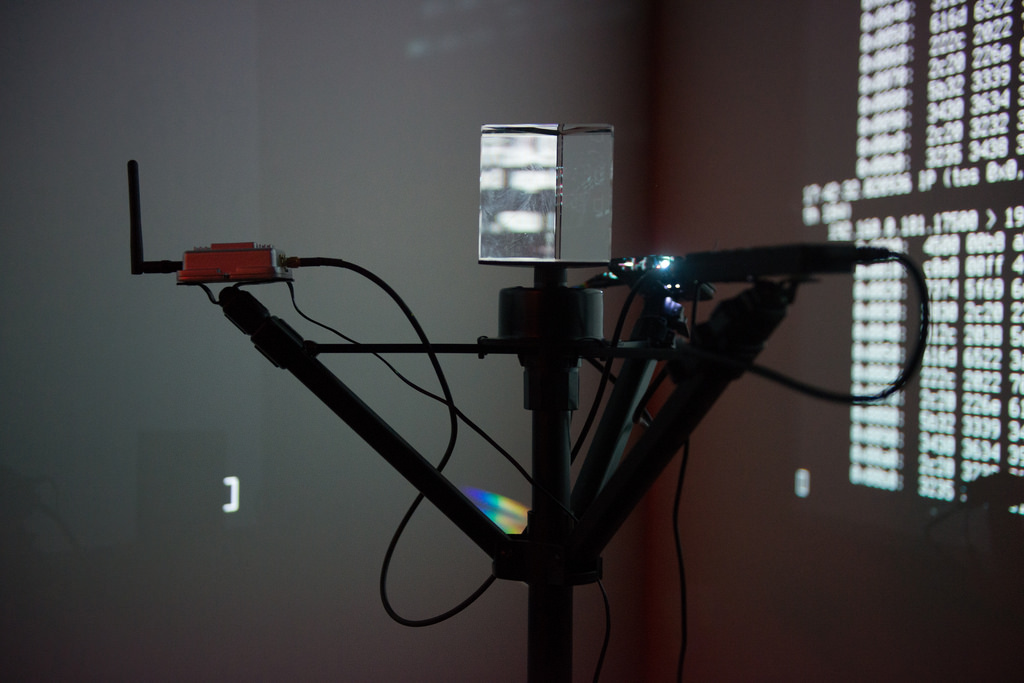 Prism is a code name for the program controlled by the US National Security Agency(NSA) who collects internet communications from various US internet companies. It was created in 2007 but hided behind authorities until June 6, 2013, when NSA contractor Edward Snowden who leaked the information to the public to warn people the extent of data collection and surveillance was greater than people thought.[1] 2013 was a big year for NSA and the public because of the leak, but nobody ever knows what is this program, Prism, physically look like. Prism: The Beacon Frame becomes the speculative, functional imagery of this unknown technology. Created by Julian Oliver, Prism: The Beacon Frame, is a series of installations of the manifestation of the artist’s imagery of the Prism program by using the same techniques of wireless device localization and mapping, cell-tower hijacking and wireless packet inspection known to be in use by state sanctioned surveillance agencies such as the GCHQ(UK) and NSA(USA)[2]
Prism is a code name for the program controlled by the US National Security Agency(NSA) who collects internet communications from various US internet companies. It was created in 2007 but hided behind authorities until June 6, 2013, when NSA contractor Edward Snowden who leaked the information to the public to warn people the extent of data collection and surveillance was greater than people thought.[1] 2013 was a big year for NSA and the public because of the leak, but nobody ever knows what is this program, Prism, physically look like. Prism: The Beacon Frame becomes the speculative, functional imagery of this unknown technology. Created by Julian Oliver, Prism: The Beacon Frame, is a series of installations of the manifestation of the artist’s imagery of the Prism program by using the same techniques of wireless device localization and mapping, cell-tower hijacking and wireless packet inspection known to be in use by state sanctioned surveillance agencies such as the GCHQ(UK) and NSA(USA)[2]
One of the installations, Prism: the Tower, is the iteration of the project with the field deployable wireless surveillance and GSM interception unit comprising a robust tripod, large glass prism, nano computer, nano projector, GSM antenna and cellular communications basestation. When the installation is activated, the computer scans for local cell towers owned by mobile service providers, copying their list of properties. Then the prism tower will start rotating and impersonate each cell provider one by one. Activated mobile phone under the coverage of those cell towers the installation scanned will automatically hop into the rogue network, recognizing and trusting its properties. Each phone will be sent SMSs of a troubling, humorous and/or sardonic nature. And the data collected from those trusting phones will be projected through the rotating prism onto the wall.


During the opening night of Transmediale 2014 where the installation was presented, PRISM: Tower interacted with over 740 phones. As Shanken writes in Art and Electronic Media, “electronic media have also been used to interrogate and actively fight censorship, corporate hegemony, pollution, gender discrimination and the proliferation of surveillance and control systems that threaten civil liberties.”[3] PRISM: Tower, which gets its name from the surveillance program that the government used against its own nation and public, is a direct response to the absence of information as to what NSA prism program should look like. At the same time, the installation demonstrate the process to the viewers in front of their faces of how easily the government can steal our communication data, which remind and warn to the public again the serious damage from the Prism surveillance and the fact that the shady government still tries to keep the program as a secret.
PRISM: Tower never got restored after the show, since the festival director pointed out that the festival and its umbrella organization could not afford to legally protect the artist from the potential chargers in Germany. Julian Oliver and Danja Vasiliev, the developers of the installation stated:
“We, the creators of “PRISM: The Beacon Frame”, wish to express our disappointment at the disabling of a crucial element of this work at Transmediale 2014, with the threat of reporting us to the German Federal Police.
As such we’ve agreed that it is not in our interests to maintain the work in its original form.
It was our intention to provide an opportunity for public to critically engage precisely the same methods of cellular communications interception used by certain governments against their own people and people in sovereign states. It was not, in any way, our intention to harm anyone and nor did we.
We note that the German Parliament, right next door, has suffered directly by way of such violations.
It is vital that technology-based art remain a frame with which we can develop critical discourses about the world we live in, from the engineered to the cultural and political. Sometimes that requires that we are not limited by exaggerated fears and legal definition, but that we act proportionally and with conscience in our efforts to understand the power struggles and tensions in our (technically mediated) environment.
Sometimes this means taking risks, risks without intention to harm but to engender wider critical insights.
We wish to thank the Festival Director and the Curatorial Team from ArtHackDay and LEAP for representing us to the best of their ability.
“The Critical Engineer considers the exploit to be the most desirable form of exposure”[4]
[1]https://www.biography.com/people/edward-snowden-21262897
[2]https://criticalengineering.org/projects/prism-the-beacon-frame/
[3]Shanken, Edward, Art and Electronic Media, 2009
[4]https://criticalengineering.org/projects/prism-the-beacon-frame/
